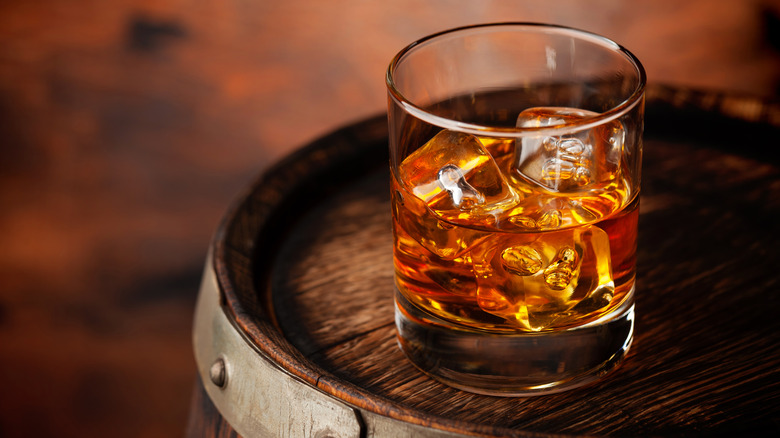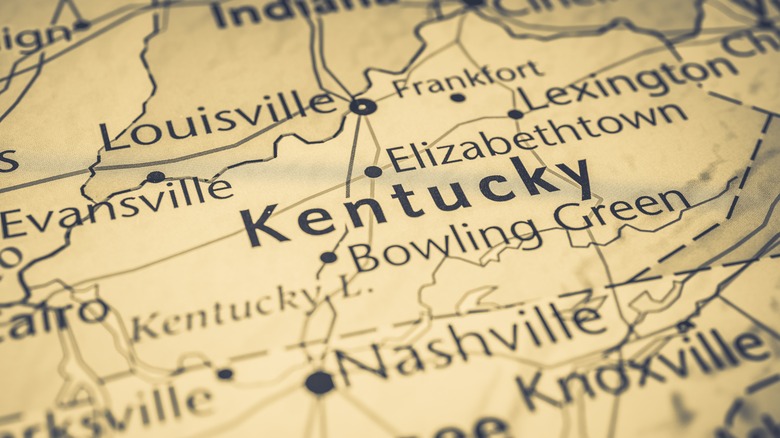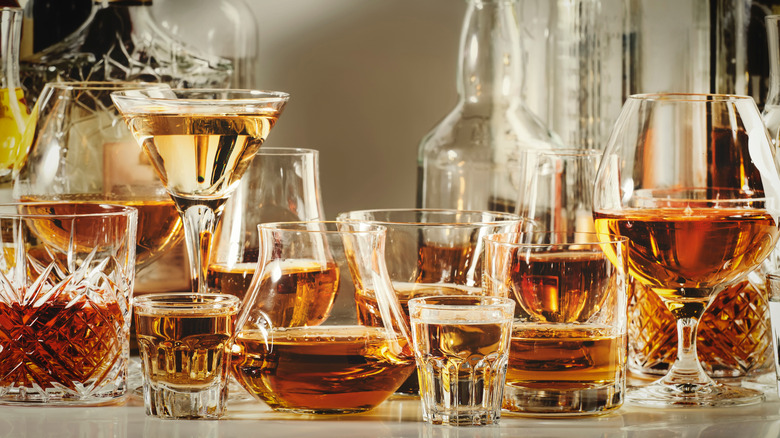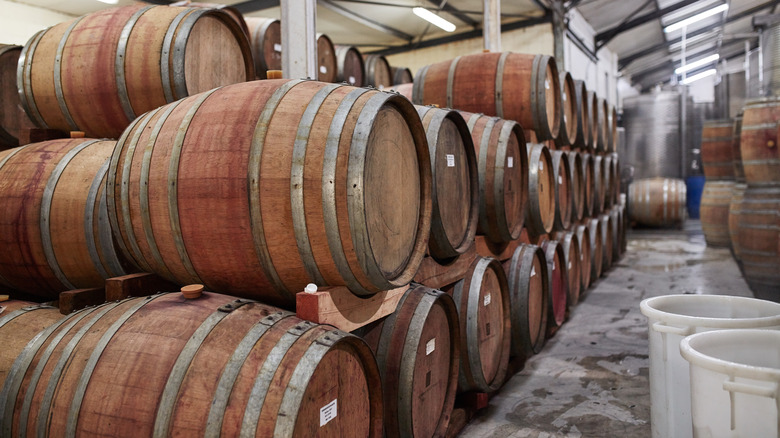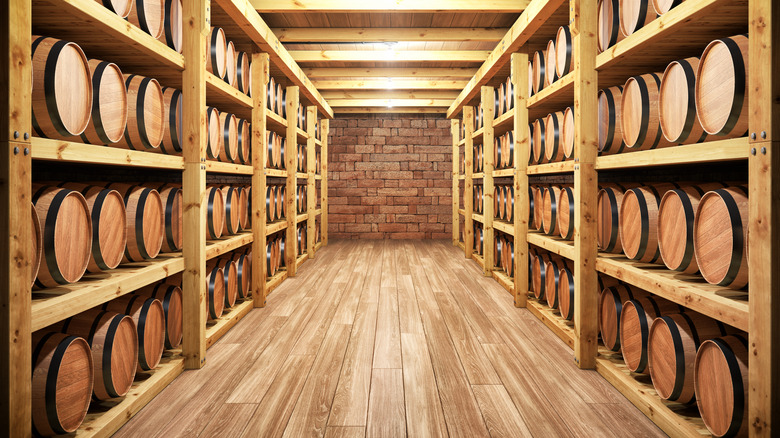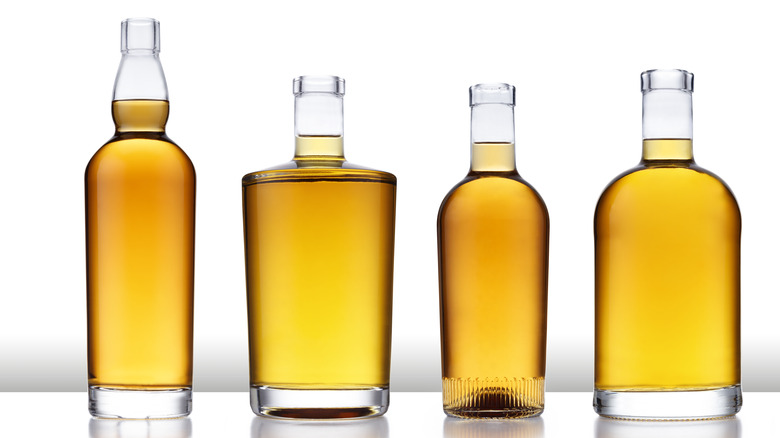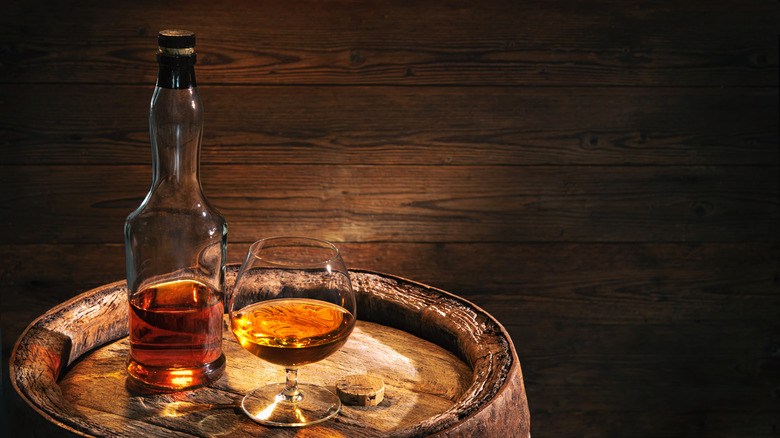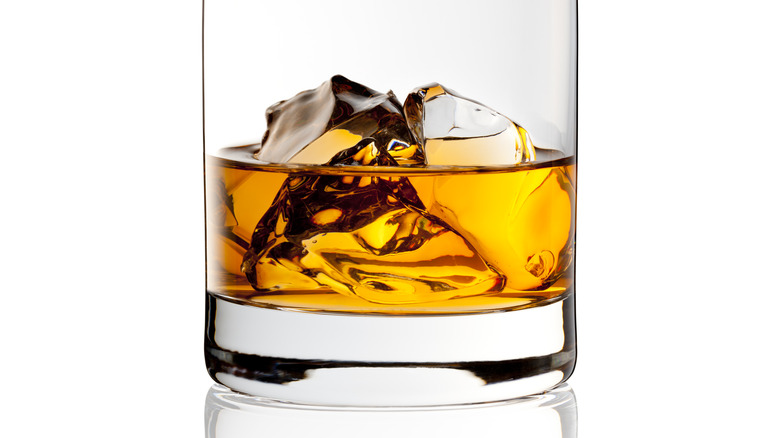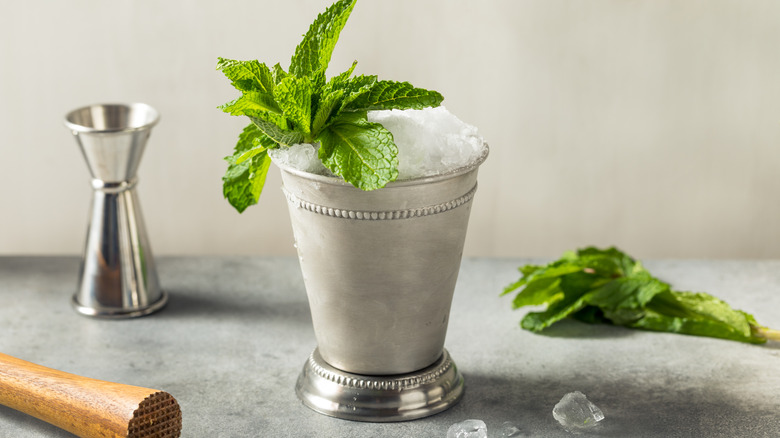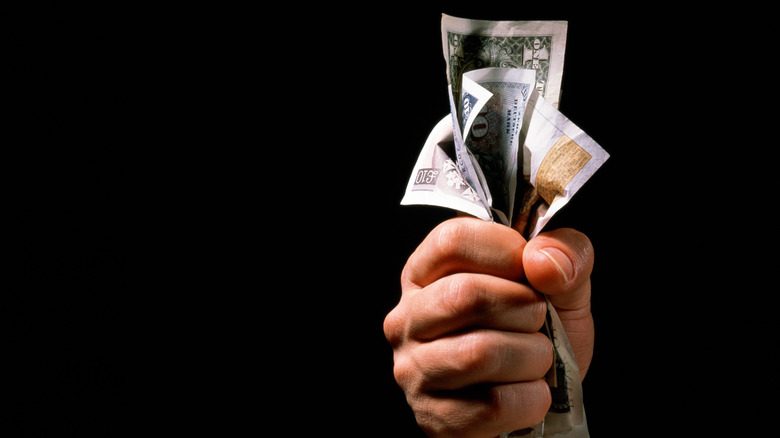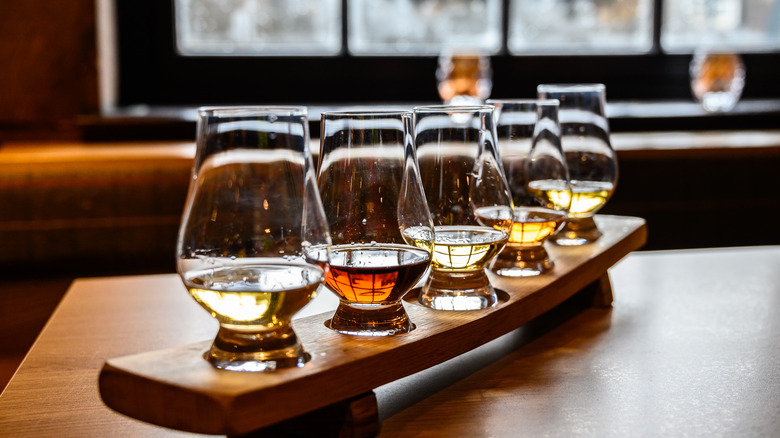10 Bourbon Myths You Need To Stop Believing
There's no shortage of drinking-related myths and legends that circulate the world of liquor. While there might be some merit in certain boozy lore (beer before liquor, anyone?), some misinformation actually takes away from the overall drinking experience — especially when it comes to bourbon. Being able to separate fact from fiction means you'll have a better understanding of the liquid in your glass, which will allow you to have an all-around better time when the craving for a bourbon drink strikes. Not only will you be able to sound like a pro when you visit a bar or distillery, but you'll also know how to make the most out of every drink.
From understanding where bourbon can be produced to learning what putting ice in your bourbon really does (hint: it's more than just keeping it cool) and finally gaining some clarity on who invented one of America's most beloved spirits, we're here to bust some of the most common bourbon legends.
1. Bourbon must be made in Kentucky
There are strict rules that determine what can be labeled and sold as bourbon. So strict, in fact, that the United States government officially outlines the rules regarding its requirements. A lot of myths arise because most average drinkers probably aren't taking the time to read through official government documents — so let's set a few things straight.
Kentucky is usually the state that comes to mind when you think about bourbon, and for good reason. A whopping 95% of the stuff is made there. However, bourbon doesn't have to be made in Kentucky to be considered bourbon. The only official rule regarding production location is that it must be made in the U.S. This means that if you come across a bottle that's labeled as bourbon, but it's made in Tennessee, it's still completely legit. In fact, we encourage you to explore bourbons that are made outside of Kentucky state lines.
2. Bourbon and whiskey are the same thing
Believe it or not, what you learned in your elementary school geometry class can actually help you understand a key fact about bourbon. Hear us out: Just like all squares are rectangles but not all rectangles are squares, all bourbon is whiskey, but not all whiskey is bourbon. The difference between bourbon and whiskey comes down to the set of government-outlined regulations we mentioned earlier.
As we said, bourbon must be made in the U.S. It also must be made from at least 51% corn, (the remaining 49% can consist of a mix of grains of the distiller's choice), stored at a maximum of 125 proof in charred, new American Oak barrels, and the final product can't exceed 160 proof. If a bottle of whiskey doesn't adhere to these regulations, distillers legally can't call it bourbon. All these rules help maintain the quality and consistency of bourbon and keep it a uniquely American spirit.
3. One bottle = one barrel
If you're like us, you probably imagine bourbon makers simply pouring the contents of a barrel into a bottle and calling it a day. While this is the case for some very high-end, very expensive "single-barrel bourbons," (Blanton's Single-Barrel, for example) this simplified scenario is the exception, not the rule.
Most bourbons are actually made from a blend of the liquid from multiple barrels. Using multiple barrels helps keep the flavor consistent. While single-barrel varieties completely take on the characteristics of the sole container in which they were aged, standard bourbon is a bit more controlled since distillers can use barrels from multiple locations in the warehouse (which impacts flavor) and that have been aging for various amounts of time.
There's another category of bourbon that falls in between standard bourbon and single-barrel bourbon called "small batch bourbon." This term isn't legally designated so "small batch" can mean 10 bottles or 200, depending on the producer.
4. Aging is always a positive
While some of the most expensive bottles of bourbon on the market have been aged for decades, bourbon absorbs the flavor of the wood barrels it's stored in as time goes on. So, if bourbon is aged for too long or aged incorrectly, the final product isn't going to taste good because the wood notes will start to overwhelm the other flavors. A hint of oak acts as a delicious tasting note, but too much oak will make you feel like you're drinking wood-flavored water. Bourbon can also taste sour or bitter if it sits in the barrel for too long.
Unlike Scotch, which largely benefits from being aged, distillers generally agree that there's a limit to how long bourbon should be aged. That said, once it's in the bottle, it will stay good indefinitely, so don't worry about pouring yourself a dram of the bottle that's been sitting in your grandpa's liquor cabinet for as long as you've been alive.
5. You can age bourbon in the bottle
While it would be nice to be able to turn a cheap, low-quality bottle of bourbon into a smooth, delicious collector's item just by hanging on to it for a few years, it simply doesn't work that way. It's easy to see why some people think that you can age whiskey in the bottle. After all, you can improve the taste and value of other libations, like wine, with nothing more than a little patience and the willpower not to crack open the bottle.
Chemical reactions between the spirit and the wood barrels in which it's aged are responsible for the changing flavor profiles in bourbon, so once the wood is out of the picture, the flavor is completely locked in. This means that if you buy a not-so-great bottle of bourbon today, it's still going to taste like a not-so-great bottle of bourbon in ten years. We hate to be the bearer of bad news, but we promise it's better to know the truth now that to find out in ten years when you crack open the bottle you purposely stored away. Long story short, drink up!
6. Bourbon has a known inventor
If you Google the phrase "who invented bourbon," you're going to be met with a plethora of conflicting information — most of which has no historical merit. There's a lot of lore that surrounds the creation of this quintessential American spirit, but no one knows for sure who invented bourbon. Elijah Craig and Jacob Spears are two common names you'll hear tossed around in the conversation, but you should conceptualize these two theories as legends instead of facts (and since they're both legends in the bourbon world, anyway, that shouldn't be too difficult).
While we might not know exactly who invented the stuff, what we do know is that there are references to spirits called bourbons that date back to the 1820s. The two centuries that followed brought about significant changes in production and popularity. Regardless of who invented it, we're happy to raise a glass in their honor.
7. Adding ice is a bad thing
If you've ever been scared to ask for ice in your glass in front of your bourbon-aficionado friends, you're not alone. Some people turn their noses up at the thought of adding a few cubes to nice dram of bourbon, but in reality, ice can actually enhance the flavors. Adding ice means adding a little bit of water to the pour, which can soften the overall flavor and open it up to reveal tasting notes you might miss otherwise.
If you're worried about too much dilution (which is definitely possible), you can try using one large ice cube since the reduced surface area on a large rock means it will melt more slowly. Bars that feature extensive whiskey collections usually have them on hand, or you can buy your own mold to have in the freezer.
The most important thing we want to say in regard to busting this myth is that you should drink what you enjoy and not allow other people's attitudes to deter you from enjoying your beverage. So, go ahead and add ice.
8. Bourbon can't be refreshing
Many people associate drinking bourbon with either drinking it on its own or drinking it in a spirit-forward cocktail like an Old Fashioned — which are not exactly what you'd call refreshing. However, brambles, mules, and other light and bright cocktails are also possible. Enjoying a frosty Kentucky Mule on a hot summer day is a great way to beat the heat, and warm weather events like the Kentucky Derby wouldn't be complete without a few mint juleps.
As much as love cozying up by the fireplace with a glass of bourbon or bourbon-spiked hot chocolate, we're also fans of drinking the spirit all year long. When you pigeonhole bourbon into an exclusively heavy, boozy category, you miss out on a lot of tasty drink possibilities.
People also tend to assume that if you don't like the taste of liquor, you won't like drinks that use bourbon as the base. Once again, we encourage you to branch out and try a few bourbon-based cocktails that feature effervescent ingredients, fresh fruit, and juice to help you expand your drinking repertoire.
9. You need to spend a lot of money to get a good bottle
The sky is the limit when it comes to how much you can shell out for a bottle of bourbon, but we promise there are a plethora of delicious, affordable options that don't cost an arm and a leg. Unless you're a serious whiskey enthusiast, you're probably not going to get enough added enjoyment out of an extra-expensive bottle, anyways. You're better off saving your money or, if you're dead-set on spending it on booze, opting for a few mid-range bottles instead of one ultra-premium one.
Now, don't get us wrong — we like nice bourbon. By no means are we telling you to go pick up a bottle of the cheapest stuff your liquor store has to offer. We're just letting you know that you can find delicious bourbon at a more affordable price point than you might think. If you do your research, keep an open mind, and take advantage of opportunities you have to try new varieties, you'll be able to find a bourbon you love that doesn't blow your budget.
10. All bourbon tastes the same
No matter what kind of bourbon you're drinking, you're going to know you're drinking bourbon. While there are similarities that exist across the entirety of this category of spirit, not all bourbon tastes the same. Some of the most common tasting notes in bourbon include vanilla and caramel, but everything from toasted marshmallow to graham cracker can be detected in different variants. You might need to train your palate (and your brain) to recognize certain variations, but the flavor profiles of different styles of bourbons can range significantly.
This rings particularly true because distillers have the freedom to use various grains in the mash bill. For example, a bourbon with a lot of rye is going to taste a lot spicier than one with a lot of wheat, which has more pronounced notes of cereal. Learning to pick up on the subtle differences in bourbon is our idea of a good time, and the only way to learn is by drinking it.
